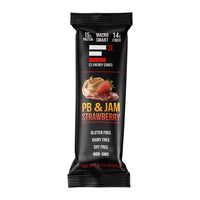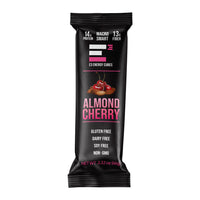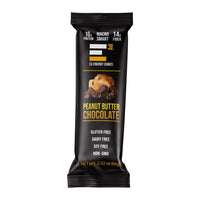Discover Delicious Gluten-Free Dairy-Free Snacks
In today's health-conscious world, the demand for gluten-free and dairy-free snacks has surged. These snacks are essential for individuals with dietary restrictions and offer many benefits required to maintain a balanced and healthy diet. Gluten-free snacks are more accessible to the digestive system and can help reduce inflammation. At the same time, dairy-free options are often lower in cholesterol and fat, making them heart-healthy.
Among these, dairy-free protein bars have become particularly popular. They provide a convenient, nutritious option for those needing a quick energy boost, making them suitable for busy professionals, athletes, or anyone on the go. Packed with plant-based proteins and natural ingredients, these bars are a delicious and wholesome alternative to traditional snacks, catering to a growing demand for healthier, more inclusive food choices.
This article provides information about gluten-free snacks and how they are healthy yet tasty alternatives to conventional snacks.
What are gluten-free snacks?

Gluten-free snacks are food items crafted without gluten. Wheat, barley, rye, and their derivatives have gluten. These snacks cater to anyone with celiac disease, gluten intolerance, or anyone trying to avoid gluten for health reasons. Typical gluten-free snacks include fruits, vegetables, nuts, seeds, and specially made products like gluten-free crackers, chips, and baked goods.
Manufacturers often use alternative grains and flour such as rice, corn, quinoa, almond, and coconut to create these snacks. This ensures that people sensitive to gluten can enjoy various tasty and nutritious options without experiencing adverse effects. With increasing awareness of dietary needs, gluten-free snacks have become widely available, providing safe and satisfying choices for anyone seeking to maintain a gluten-free diet while enjoying their favorite foods.
How Are Gluten And Dairy-Free Snacks Made?
Gluten- and dairy-free snacks use alternative ingredients to replace traditional wheat and dairy products. For gluten-free snacks, manufacturers use grains and flours such as rice, corn, quinoa, and almonds instead of wheat, barley, or rye. These substitutes provide similar textures and flavors without triggering gluten sensitivities.
Almond, coconut, soy, and other non-dairy alternatives are plant-based alternatives for dairy-free snacks instead of cow's milk. These ingredients can mimic the creamy textures and flavors of dairy products, making them suitable for those with lactose intolerance or dairy allergies. Plant-based oils like coconut or olive oil often replace butter in recipes.
Both snacks undergo rigorous testing to ensure they meet strict gluten- and dairy-free standards. This meticulous production process ensures that the final products are safe, nutritious, and enjoyable for individuals with dietary restrictions.
The E3 Energy Cubes gluten-free snacks are made from delicious ingredients like blueberries, soy milk, and more. Learn all about the benefits of gluten-free and dairy-free protein bars here.
Why Are Gluten-Free Snacks Gaining Popularity?

Gluten-free snacks are rapidly gaining popularity, and this trend can be attributed to various factors.
Increased Awareness
One significant reason for the surge in gluten-free snack popularity is the growing awareness and diagnosis of health issues like celiac disease and gluten sensitivity. As more individuals are diagnosed with these conditions, the demand for gluten-free options has risen. This shift has prompted food manufacturers to develop a wider variety of gluten-free products, catering to those with health reasons to avoid gluten.
Healthier Lifestyle Choices
The appeal of gluten-free snacks extends beyond those with medical needs. Many people without gluten intolerances are turning to gluten-free products as part of a healthier lifestyle. There is a growing perception that gluten-free snacks are inherently healthier, often made with whole grains, seeds, nuts, and other nutritious ingredients. These snacks tend to be lower in processed sugars and additives, aligning with the clean eating movement, which emphasizes minimally processed foods.
Alignment with Popular Dietary Trends
The rise in gluten-free snacks can also be attributed to broader dietary trends. Diet plans like the Paleo and Keto often limit or eliminate gluten-containing grains. As these diets gain followers, the market for gluten-free snacks expands to accommodate their requirements. This alignment with popular dietary practices has significantly contributed to the growth in gluten-free snack consumption.
Improvements in Product Quality
The food industry has responded to the increasing demand for gluten-free options by improving the quality and variety of gluten-free products. Where once gluten-free options were limited and often lacking in taste and texture, advancements in food technology have led to a proliferation of delicious and satisfying gluten-free snacks. This quality improvement has made these products more appealing to a broader audience, ensuring that gluten-free does not compromise flavor or enjoyment.
Influence of Marketing and Media
Marketing and media also play a pivotal role in popularizing gluten-free snacks. Celebrities and influencers who promote gluten-free diets as part of a healthy lifestyle can significantly impact consumer behavior. As these endorsements reach large audiences, more people become interested in gluten-free snacks, contributing to their growing popularity. The visibility and endorsement by well-known figures help to normalize gluten-free eating, encouraging more individuals to check out these options.
Different Types Of Dairy Alternatives And Their Benefits
Dairy alternatives have become increasingly popular due to rising lactose intolerance, milk allergies, and dietary preferences such as veganism. These alternatives offer various health benefits and cater to diverse tastes and nutritional needs.
Almond Milk
Almond milk is a widely favored dairy alternative. It is low in calories and rich in vitamins D and E, essential for bone health and skin maintenance. Almond milk is also naturally lactose-free, making it an excellent choice for lactose intolerance patients.
Soy Milk
Soy milk is another popular option. It is protein-rich and contains essential amino acids. It has calcium and vitamin D, which support bone health. Due to its isoflavones content, soy milk can help reduce cholesterol levels, promoting heart health.
Coconut Milk
Coconut milk contains medium-chain triglycerides (MCTs), which can boost energy and metabolism. It is also thick in texture and a good source of lauric acid, which is known for its antimicrobial properties and benefits the immune system.
Oat Milk
Oat milk is rich in beta-glucans, which can help lower cholesterol and improve heart health. It is also a good source of fiber, aiding digestion. Oat milk is boosted with additional vitamins and minerals, which enhances its nutritional profile.
Cashew Milk
Cashew milk is creamy and sweet, containing healthy fats, vitamins, and minerals. It is low in calories and a good source of magnesium, which supports muscle and nerve function.
How To Choose The Right Snacks That Are Nutritious And Tasty?
Choosing nutritious and tasty snacks can be straightforward, with a few key considerations. First, prioritize whole, minimally processed foods like fruits, vegetables, nuts, and seeds, which naturally offer a wealth of nutrients and flavor. Look for snacks high in fiber, healthy fats, and proteins to satisfy and energize you.
Consider Protein Bars
Protein bars are convenient, nutrient-dense snack. When selecting protein bars, especially those that are gluten-free and dairy-free, pay attention to the ingredient list. Opt for bars with natural, recognizable ingredients such as wild seeds and plant-based protein sources like peas or rice. Avoid bars with added sugars, artificial sweeteners, and preservatives.
Check Labels Carefully
Ensure the bar is certified gluten-free and dairy-free to avoid potential allergens. Check certifications or labels indicating that the product has been tested and verified. Additionally, choose bars that offer a good balance of nutrients to provide sustained energy and fullness.
Taste Matters
Lastly, don't compromise on taste. Many gluten- and dairy-free protein bars come in various flavors, so try different options to find ones you enjoy. A tasty snack will be more satisfying, and you can consistently maintain healthy eating goals.
Drawbacks Of Gluten And Dairy-Free Snacks
While gluten and dairy-free snacks offer numerous health benefits, they can have drawbacks. These snacks are often more expensive than conventional options and may contain fewer vitamins and minerals if not carefully chosen. Additionally, some gluten-free products rely on refined starches, which are lower in fiber and nutrients. Despite these issues, gluten and dairy-free snacks remain a healthier choice for those with intolerances or dietary preferences. They provide essential nutrients, cater to specific dietary needs, and contribute to overall well-being when selected thoughtfully.
Who Can Have Gluten-Free, Dairy-Free Snacks?
Gluten-free, dairy-free snacks are suitable for a variety of individuals. Those with celiac disease, gluten sensitivity, or lactose intolerance benefit significantly from these options, as they help avoid digestive issues and other related symptoms. Additionally, people with milk allergies or who follow vegan diets can enjoy these snacks without compromising their dietary restrictions. Health-conscious individuals without specific intolerances also choose gluten-free, dairy-free snacks for their perceived health benefits, such as reduced inflammation and lower cholesterol. These snacks cater to diverse dietary needs and preferences, making them accessible to a broad audience.
Wrapping Up
In conclusion, gluten- and dairy-free snacks provide a nutritious and inclusive option for various dietary needs and preferences. These snacks support digestive health, reduce inflammation, and cater to those with specific intolerances or allergies. Whether you're an athlete seeking a quick energy boost or simply looking for healthier snack choices, the market offers an ever-expanding array of delicious and wholesome options.
The E3 Energy Cubes collection would be a go-to choice for those looking to improve their snacking experience. Our variety of flavors ensures something for everyone, combining convenience with superior nutrition. Visit E3 Energy Cubes to find your perfect snack today!
FAQs
- Are gluten-free, dairy-free snacks healthier than regular snacks?
Gluten-free and dairy-free snacks can be healthier if made with whole, minimally processed ingredients. They often contain fewer additives and artificial ingredients compared to regular snacks. However, checking the nutritional content is important, as some gluten-free products may lack essential nutrients.
- Can I lose weight by eating gluten-free, dairy-free snacks?
Eating gluten-free, dairy-free snacks alone won't guarantee weight loss, but they can be part of a balanced diet. Choosing snacks high in fiber and protein makes you feel fuller while reducing overall calorie intake. Pair these snacks with a healthy diet and regular exercise for best results.
- What should I look for on labels when buying gluten-free, dairy-free snacks?
When buying gluten-free dairy-free snacks, look for certifications like "certified gluten-free" and "dairy-free" to ensure they meet dietary standards. Check the ingredient list for whole, natural ingredients, and avoid added sugars, artificial flavors, and preservatives. Also, the nutritional information should be reviewed to ensure the snacks balance protein, fiber, and healthy fats.
- Are there any gluten-free, dairy-free snacks for athletes?
Yes, plenty of gluten-free, dairy-free snacks are explicitly designed for athletes. Look for protein bars, energy bites, and recovery drinks that use plant-based proteins and natural ingredients. These snacks provide essential nutrients and energy for optimal athletic performance and recovery.
- Can kids enjoy gluten-free dairy-free snacks?
Kids can enjoy gluten-free, dairy-free snacks and many tasty, nutritious options for young palates. Look for snacks that are fortified with vitamins and minerals to support growth and development. Always review the ingredient list to ensure it meets your child's dietary needs and preferences.







Leave a comment